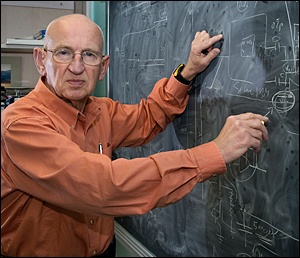Apr 28 2009
The IEEE's Long Island Section has honored Veljko Radeka, head of the Instrumentation Division at the U.S. Department of Energy's (DOE) Brookhaven National Laboratory, with the Harold Wheeler Award. IEEE, formerly known as the Institute of Electrical and Electronics Engineers, Inc., is the world's leading professional association for the advancement of technology, and Wheeler was a world-famous engineer, who made important technical contributions at Wheeler Labs and Hazeltine Corporation.

Radeka received a plaque from IEEE with the citation: “For outstanding leadership and accomplishments in detector development which enabled discoveries in many areas of science and technology in a career of sustained productivity spanning over 50 years.”
“I am honored to receive this award,” Radeka said, “and I am particularly proud of the achievements by my colleagues in the Instrumentation Division and the recognition that they have received at BNL and elsewhere.”
Under Radeka's direction, Brookhaven Lab's Instrumentation Division develops state-of-the-art instrumentation required for experimental research programs at Brookhaven Lab and maintains expertise and facilities in specialized high-technology areas. The division's research also has a significant impact on programs throughout the world that rely on state-of-the-art radiation detectors and low-noise electronics.
Radeka and his colleagues have developed numerous state-of-the-art detectors that are used in major facilities at Brookhaven Lab and around the world. For example, in the 1970s, he worked with William Willis, formerly of Yale University and Brookhaven, currently at Columbia University, to develop noble liquid argon calorimeters – detectors used in high-energy physics experiments at most major facilities, including the CERN, the European Organization for Nuclear Research in Geneva, Switzerland. This early work led to Brookhaven's contributing key components to the ATLAS detector in CERN's Large Hadron Collider, the world's most powerful particle accelerator. Continuing these developments, Radeka and his colleagues are working on the technology for large neutrino detectors to be used in the future.
Similarly, the development of highly sensitive low-noise electronics for germanium gamma ray detectors used for basic studies in nuclear physics has enabled Brookhaven Lab to play a leading role in many detector developments. An example is development of optical sensors for the Large Synoptic Survey Telescope, the world's largest telescope due to be operational by 2017.
Radeka and his colleagues in the Instrumentation Division also developed neutron detectors for studies of biological molecular structures used at the Spallation Neutron Source at DOE's Oak Ridge National Laboratory, DOE's Los Alamos Laboratory and other neutron research facilities. A major current activity is development of x-ray detectors used in synchrotrons, such as Brookhaven's National Synchrotron Light Source.
Veljko Radeka earned a Ph.D. in engineering sciences from the University of Zagreb, Croatia, in 1961, at the same time he was working on nuclear instrumentation at the Institute Ruder Boskovic in Zagreb. Radeka came to Brookhaven Lab as visiting scientist from 1962 to 1964 and joined the staff of Brookhaven's Instrumentation Division in 1966.
Radeka rose through the ranks to become head of the Instrumentation Division in 1972. Under his leadership, his division became the foremost resource in radiation detector and microelectronics research and development among Department of Energy laboratories. Radeka has authored or co-authored about 170 peer-reviewed papers, and several of his papers have been reprinted in books as classic contributions.
Radeka is a Life Fellow of IEEE and a Fellow of the American Physical Society. He received the 1983 Merit Award of the Nuclear and Plasma Sciences Society, and he is also a recipient of the IEEE Centennial Medal.